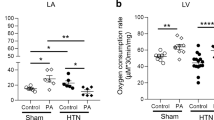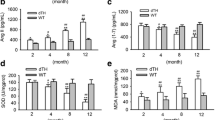Abstract
The purpose of this study is to investigate myocardial nitric oxide synthase (NOS) activity and connexin-43 (Cx43) expression in young and old spontaneously hypertensive rats (SHR), adult hereditary hypertriglyceridemic (HTG) rats, and age-matched healthy rats without and with omega-3 PUFA supplementation for 2 months. Results showed that comparing to healthy rats the myocardial NOS activity was significantly increased in young SHR (8.2 ± 1.16 vs. 1.37 ± 0.67 pmol/min/mg) as well as old SHR (3.21 ± 0.75 vs. 2.22 ± 0.56 pmol/min/mg) and to much lesser extent in HTG rats, i.e., 1.87 ± 0.42 vs. 1.34 ± 0.1 pmol/min/mg. In parallel, there was a significant decline of total and phosphorylated forms of Cx43 in both groups of SHR while not in HTG rat hearts in which phosphorylated form of Cx43 was increased. Elevated NOS activity was suppressed (P < 0.05) in young and old SHR supplemented with omega-3 PUFA and it was associated with up-regulation of Cx43. In contrast to SHR, elevation of NOS activity in HTG rat hearts was not affected by treatment with omega-3 PUFA. However, increase of phosphorylated form of Cx43 was suppressed. In conclusion, there is an inverse relationship between myocardial NOS activity and Cx43 expression in SHR while not HTG rat hearts and omega-3 PUFA modulate both NOS activity and Cx43 expression. Whether over-expression of inducible NOS might account for down-regulation of myocardial Cx43 and whether its up-regulation is associated with an increase of endothelial NOS should be explored in further study.







Similar content being viewed by others
References
Salameh A, Dhein S (2005) Pharmacology of gap junctions? New pharmacological targets for treatment of arrhythmia, seizure and cancer? Biochim Biophys Acta 1719:36–58
Severs NJ, Dupont E, Coppen SR, Halliday D, Inett E, Baylis D, Rothery S (2004) Remodelling of gap junctions and connexin expression in heart disease. Biochim Biophys Acta 1662:138–148
Tribulova N, Knezl V, Okruhlicova L, Slezak J (2008) Myocardial gap junctions: targets for novel approaches in the prevention of life-threatening cardiac arrhythmias. Physiol Res 57:S1–S13
Tribulova N, Knezl V, Shainberg A, Seki S, Soukup T (2009) Thyroid hormones and cardiac arrhythmias. Vascul Pharmacol 52:102–112
Kunes J, Hojna S, Kadlecova M (2004) Altered balance of vasoactive systems in experimental hypertension: the role of relative NO deficiency. Physiol Res 53:23–34
Kopincova J, Puzserova A, Bernatova I (2008) Chronic low-dose L-NAME treatment effect on cardiovascular system of borderline hypertensive rats: feedback regulation? Neuro Endocrinol Lett 29:784–789
Förstermann U, Boissel J, Kleinert H (1998) Expressional control of the constitutive’ isoforms of nitric oxide synthase (NOS I and NOS III). FASEB J 12:773–790
Maes M, Mihaylova I, Kubera M, Bosmans E (2007) Not in the mind but in the cell: increased production of cyclo- oxygenase 2 and inducible NO synthase in chronic fatigue syndrome. Neuro Endocrinol Lett 28:463–469
Hoffmann A, Gloe T, Pohl U, Zahler S (2003) Nitric oxide enhances de novo formation of endothelial gap junctions. Cardiovasc Res 60:421–430
Roh CR, Heo JH, Yang SH, Bae DS (2002) Regulation of connexin 43 by nitric oxide in primary uterine myocytes from term pregnant women. Am J Obstet Gynecol 187:434–440
Miyachi E, Murakami M, Nakaki T (1990) Arginine blocks gap junctions between retinal horizontal cells. Neuroreport 1:107–110
Bernatova I, Conde MV, Kopincova J, Gonzalez MC, Puzserova A, Arribas SM (2009) Endothelial dysfunction in spontaneously hypertensive rats focus on methodological aspects. J Hypertens 27:27–31
Zicha L, Pechanova O, Cacanyiova S, Cebova M, Kristek F, Tőrok J, Simko F, Dobesova Z, Kunes J (2006) Hereditary hypertriglyceridemic rat: a suitable model of cardiovascular disease and metabolic syndrome? Physiol Res 55:49–63
Grunfeld S, Hamilton CA, Mesaros S, McClain SW, Dominiczak AF, Bohr DF, Malinsky T (1995) Role of superoxide in the depressed nitric oxide production by the endothelium of genetically hypertensive rats. Hypertension 26:854–857
Dhalla NS, Temsah RM, Netticadan T (2000) Role of oxidative stress in cardiovascular diseases. J Hypertens 18:655–673
Ambrozova G, Pekarova M, Lojek A (2010) Effect of polyunsaturated fatty acids on the reactive oxygen and nitrogen species production by raw 264.7 macrophages. Eur J Nutr 49:133–139
Ren J, Chung SH (2007) Anti-inflammatory effect of alpha-linolenic acid and its mode of action through the inhibition of nitric oxide production and inducible nitric oxide synthase gene expression via NF-kappaB and mitogen-activated protein kinase pathways. J Agric Food Chem 55:5073–5080
Champeil-Potokar G, Chaumontet C, Guesnet P, Lavialle M, Denis I (2006) Docosahexaenoic acid (22:6n–3) enrichment of membrane phospholipids increases gap junction coupling capacity in cultured astrocytes. Eur J Neurosci 24:3084–3090
Dlugosova K, Okruhlicova L, Mitasikova M, Sotnikova R, Bernatova I, Weismann P, Slezak J, Tribulova N (2009) Modulation of connexin-43 by omega-3 fatty acids in the aorta of old spontaneously hypertensive rats. J Physiol Pharmacol 60:63–69
Mitasikova M, Smidova S, Macsaliova A, Knezl V, Dlugosova K, Okruhlicova L, Weismass P, Tribulova N (2008) Aged male and female spontaneously hypertensive rats benefit from n-3 polyunsaturated fatty acids supplementation. Physiol Res 57:39–48
Leaf A, Kang JX, Xiao YF, Billman GE (2003) Clinical prevention of sudden cardiac death by n-3 polyunsaturated fatty acids and mechanism of prevention of arrhythmias by n-3 fish oils. Circulation 107:2646–2652
Sharma R, Raghuram TC, Rao UB, Moffatt RJ, Krishnaswamy K (2010) The effect of fat intake and antihypertensive drug therapy on serum lipid profile: a cross-sectional survey of serum lipids in male and female hypertensives. Mol Cell Biochem http://www.springerlink.com/content/qv726tkv5t237q75/fulltext.html. Accessed 4 June 2010
Marchioli R, Marfisi RM, Borrelli G, Chieffo C, Franzosi MG, Levantesi G, Maggioni AP, Nicolosi GL, Scarano M, Silletta MG, Schweiger C, Tavazzi L, Tognoni G (2007) Efficacy of n-3 polyunsaturated fatty acids according to clinical characteristics of patients with recent myocardial infarction: insights from the GISSI-prevenzione trial. J Cardiovasc Med (Hagerstown) 8(Suppl 1):34–37
Billman GE, Kang JX, Leaf A (1999) Prevention of sudden cardiac death by dietary pure omega-3 polyunsaturated fatty acids in dogs. Circulation 99:2452–2457
Bing OH, Brooks WW, Robinson KG, Slawsky MT, Hayes JA, Litwin SE, Sen S, Ch Conrad (1995) The spontaneously hypertensive rat as a model of the transition from compensated left ventricular hypertrophy to failure. J Mol Cell Cardiol 27:383–396
Bernatova I, Kopincova J, Puzserova A, Janega P, Babal P (2007) Chronic low-dose L-NAME treatment increases nitric oxide production and vasorelaxation in normotensive rats. Physiol Res 56(Suppl 2):S17–S24
Tribulova N, Okruhlicova L, Novakova S, Pancza D, Bernatova I, Pechanova O, Weismann P, Manoach M, Seki S, Mochizuki S (2002) Hypertension-related intermyocyte junction remodelling is associated with a higher incidence of low-K(+)-induced lethal arrhythmias in isolated rat heart. Exp Physiol 87:195–205
Tribulova N, Okruhlicova L, Imanaga I, Hirosawa N, Ogawa K, Weismann P (2003) Factors involved in the susceptibility of spontaneously hypertensive rats to low K+-induced arrhythmias. Gen Physiol Biophys 22:369–382
Tribulova N, Dupont E, Soukup T, Okruhlicova L, Severs NJ (2005) Sex differences in connexin-43 expression in left ventricles of aging rats. Physiol Res 54:705–708
Dhein S (1998) Gap junctional channels in cardiovascular system: pharmacological and physiological modulation. Trends Pharmacol Sci 19:229–241
Hobbs AJ, Higgs A, Moncada S (1999) Inhibition of nitric oxide synthase as a potential therapeutic target. Annu Rev Pharmacol Toxicol 39:191–220
Vaziri ND, Ni Z, Oveisi F, Trnavsky-Hobbs DL (2000) Effect of antioxidant therapy on blood pressure and NO synthase expression in hypertensive rats. Hypertension 36:957–964
Cheng PY, Chen JJ, Yen MH (2004) The expression of heme oxygenase-1 and inducible nitric oxide synthase in aorta during the development of hypertension in spontaneously hypertensive rats. Am J Hypertens 17:1127–1134
Kimura M, Ushijima I, Hiraki M, Kimura M, Ono N (2009) Enhancement of caffeine induced locomotor hyperactivity produced by the combination with l arginine or taurine in mice: possible involvement of nitric oxide. Methods Find Exp Clin Pharmacol 31:585–589
Kim SW, Moon KH, Lee SC, Kim NH, Kang DG, Lee JU, Choi KC, Kang YJ (1999) Altered renal expression of nitric oxide synthase isozymes in spontaneously hypertensive rats. Korean J Intern Med 14:21–26
Hong HJ, Loh SH, Yen MH (2000) Suppression of the development of hypertension by the inhibitor of inducible nitric oxide synthase. Br J Clin Pharmacol 131:631–637
Jackson PEM, Feng QP, Jones DL (2008) Nitric oxide depresses connexin 43 after myocardial infarction in mice. Acta Physiol 194:23–33
Moibenko O, Shysh A, Kukoba T, Kotsjuruba A, Kharchenko O (2007) N-3 polyunsaturated fatty acids and nitric oxide synthases activity. J Mol Cell Cardiol 42:S207
Harris WS, Rainbjør GS, Windsor SL, Diederich D (1997) N-3 Fatty acids and urinary excretion of nitric oxide metabolites in humans. Am J Clin Nutr 65:459–464
Huang PL (2009) eNOS, metabolic syndrome and cardiovascular disease. Trends Endocrinol Metab 20:295–302
Kishi T, Hirooko Y, Mukai Y, Shimokawa H, Takeshita A (2003) Atorvastatin causes depressor and sympatho-inhibitory effects with upregulation of nitric oxide synthases in stroke-prone spontaneously hypertensive rats. J Hypertens 21:379–386
Shih CD (2009) Activation of nitric oxide/cGMP/PKG signaling cascade mediates antihypertensive effects of Muntingia calabura in anesthetized spontaneously hypertensive rats. Am J Chin Med 37:1045–1058
Kameritsch P, Khandoga N, Nagel W, Hundhausen C, Lidington D, Pohl U (2005) Nitric oxide specifically reduces the permeability of Cx37-containing gap junctions to small molecules. J Cell Physiol 203:233–242
Radosinska J, Bacova B, Knezl V, Barancik M, Weismann P, Tribulova N (2010) Up-regulation of myocardial connexin-43 and PKCe is most likely involved in cardioprotective-antiarrhythmic effects of omega-3 fatty acids in old hypertensive rats. J Hypertens 28:e498
Tribulova N, Bacova B, Radosinska J, Knezl V, Barancik M, Slezak J (2010) Chronic and acute treatment with atorvastatin and omega-3 fatty acids protects against malignant arrhythmias. Are intercellular connexin channels implicated? Eur Heart J 3:545
Gönczi M, Papp R, Kovács M, Seprényi G, Végh A (2009) Modulation of gap junctions by nitric oxide contributes to the anti-arrhythmic effect of sodium nitroprusside? Br J Pharmacol 156:786–793
Rickover O, Zinman T, Kaplan D, Shainberg A (2007) Exogenous nitric oxide triggers classic ischemic preconditioning by preventing intracellular Ca2+ overload in cardiomyocytes. Cell Calcium 43:324–333
Tribulova N, Seki S, Radosinska J, Kaplan P, Babusikova E, Knezl V, Mochizuki S (2009) Myocardial Ca2+ handling and cell-to-cell coupling, key factors in prevention of sudden cardiac death. Can J Physiol Pharmacol 87:1120–1129
Acknowledgments
This study was supported by VEGA 2/0049/09, APVV 51-059505, APVT-51-018-004 and APVV SK-UA-0022-09 Grants. Omega-3 PUFA was generous gift of ProBio Company, Norway.
Author information
Authors and Affiliations
Corresponding author
Rights and permissions
About this article
Cite this article
Radosinska, J., Bacova, B., Bernatova, I. et al. Myocardial NOS activity and connexin-43 expression in untreated and omega-3 fatty acids-treated spontaneously hypertensive and hereditary hypertriglyceridemic rats. Mol Cell Biochem 347, 163–173 (2011). https://doi.org/10.1007/s11010-010-0625-0
Received:
Accepted:
Published:
Issue Date:
DOI: https://doi.org/10.1007/s11010-010-0625-0




